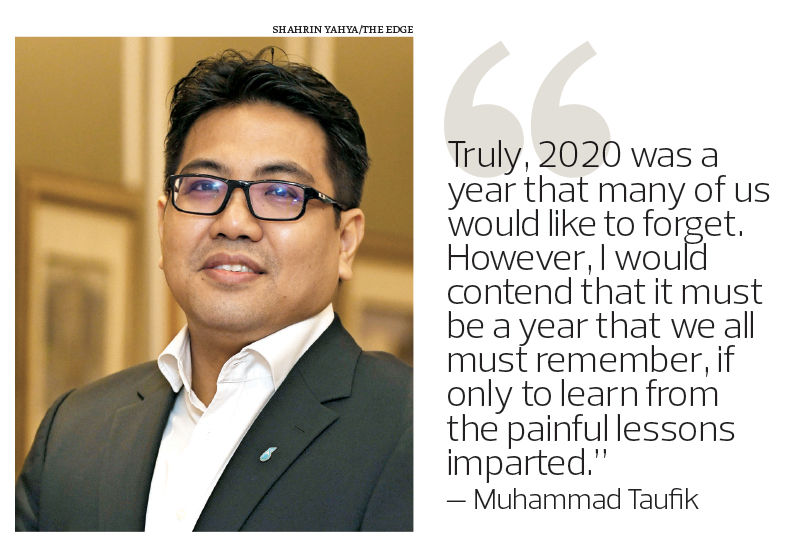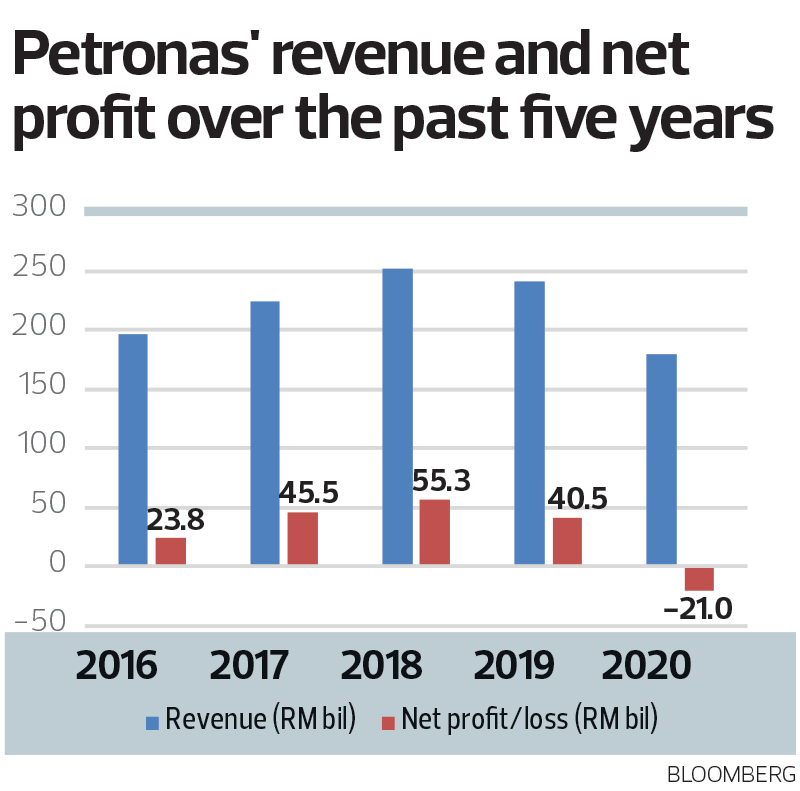
This article first appeared in The Edge Malaysia Weekly on March 1, 2021 - March 7, 2021
THE plunge in oil prices last March brought about a particularly challenging year for Petroliam Nasional Bhd (Petronas). The national oil major was dragged into an annual loss of RM21 billion for the financial year ended Dec 31, 2020, amid twin shock events — the oil price crash and demand destruction.
Petronas president and CEO Tengku Muhammad Taufik Aziz says the market conditions were unprecedented as crude oil prices took a nosedive following the collapse of the Opec+ alliance in early March last year, as well as the disruption to oil demand due to the stringent measures taken to contain the Covid-19 pandemic.
This resulted in the national oil major’s annual revenue shrinking nearly 26% to RM178.7 billion from RM240.3 billion in FY2019, on the back of plummeting oil prices and lower sales volumes for processed gas, petroleum products and liquefied natural gas (LNG).
Brent crude oil averaged US$42 per barrel in 2020 — the lowest since 2004 — compared with US$64.30 in 2019 while West Texas Intermediate crude oil dove into negative territory at -US$37 per barrel on April 20 last year.
“Truly, 2020 was a year that many of us would like to forget. However, I would contend that it must be a year that we all must remember, if only to learn from the painful lessons imparted,” said Muhammad Taufik during a virtual briefing on the group’s FY2020 results last Friday.
“Petronas tackled the twin shock events with careful measures and deliberate actions to minimise impact and ensure recovery pathways were preserved amid an accelerating energy transition.”
The group had taken a RM31.5 billion impairment charge on assets — its biggest impairment to date — which resulted in its first ever net loss. Excluding the impairment, it would have posted a net profit of RM10.5 billion, a 78% decline from RM48.8 billion in FY2019.
Amid the challenging conditions, Petronas took deliberate steps to lower its costs and exceeded its targets to reduce operational expenditure (opex) and capital expenditure (capex) by 12% and 21% respectively. The group spent RM33.4 billion on capex in FY2020 — 30% lower than the preceding year’s RM47.8 billion.
Muhammad Taufik said the outlook will remain challenging moving forward, especially for the oil and gas industry, which has been heavily influenced by the “unprecedented events of 2020”. “Petronas remains resolute in our efforts to execute our tactical interventions while taking deliberate steps to shape our portfolio, retool our ecosystem and place continuing emphasis on focused execution to future-proof our organisation.”
He added that the group’s ongoing efforts to safeguard its revenue and carry out cost optimisation will continue in order to mitigate the negative impact from potential shocks to its profitability and liquidity.
Capex of RM40 bil to RM45 bil a year until 2025
Petronas will be spending between RM40 billion and RM45 billion in capex per year over the next five years, with the amount split on a 55:45 basis between domestic and international projects. About 9% of its annual capex will be allocated to new energy initiatives, which is almost double the 5% allocated in 2020, said Muhammad Taufik.
The chieftain, who took over the reins in June last year, stressed the importance of Petronas making the transition to renewables as legislation around the world as well as stakeholders emphasise sustainability in energy generation. “I understand the intensity of queries around how we are measuring, recognising and doing something about our carbon footprint, which is increasingly on the minds of financiers,” he said.
He added that Petronas has “very little choice” in the matter and therefore it has to take measured, deliberate and careful steps forward, in line with its commitment to net-zero emissions by 2050.
In 2020, Petronas paid a total of RM34 billion in dividends to its shareholders, comprising an initial payment of RM24 billion and another RM10 billion paid at end-November 2020.
No request for more dividends yet
For 2021, the group’s board approved the payment of RM18 billion in dividends to the federal government, in line with what was announced in Budget 2021. Muhammad Taufik reiterated that the group could still contend with this amount of payout.
Asked if there were any requests for special dividends this year, given the challenging situation with the ongoing pandemic, he said there had been no requests so far from its shareholder, namely the federal government, although any decision would need to go through the board of directors first, he pointed out.
“We always make dividend decisions premised on whether we can afford it — whether we can contend with capex, opex, debt servicing and the need to actually have a buffer to weather volatility, which has been pronounced,” said Muhammad Taufik.
Saudi Aramco remains committed to Pengerang
There have been rumours that the partnership between Saudi Aramco and Petronas is breaking up and that has hindered the progress of the Pengerang Refining and Petrochemical Integrated Refinery and Petrochemicals Complex project, which forms part of the larger US$27 billion Pengerang Integrated Petroleum Complex in southern Johor.
Muhammad Taufik, however, reiterated that both parties are still committed to the partnership. “Petronas and Saudi Aramco remain committed to the partnership and delivering the successful and reliable start-up of this signature 300,000 barrels per day facility. They have deployed their best resources to complement our team. I do not want to entertain any speculation on the partnership,” he said.
Saudi Aramco officially entered into the project in 2017, when it signed a US$7 billion share purchase agreement to own a 50% stake in the refinery and the steam cracker plant. Under the joint venture, it is expected to supply up to 70% of the crude feedstock requirements of the refinery, while the project gives the company an opportunity to expand in Southeast Asia and new geographies for its crude oil production. Petronas, on the other hand, will supply gas, power and other utilities.
On the timeline for the completion of the facility, Muhammad Taufik said the schedule has been pushed back owing to the recent surge in Covid-19 cases, which resulted in a number of clusters emerging in Johor.
Petronas executive vice-president and CEO (Downstream) Datuk Md Arif Mahmood explained that the group was previously gearing up to start up in March, but is now looking at the early part of the second half of 2021. “Just to give you a feel [of the situation], there are still about 4,000 workers, contractors on the site, plus our own personnel of about more than 2,000 people. We need to make sure we manage carefully this work and the risk of Covid-19, which has impacted the schedule.”
To recap, an explosion and a fire at the facility in April 2019 delayed commencement to mid-2020. But another explosion in March last year deferred the start-up to 4Q2020 before it was again being pushed back to 1Q2021.
The oil refinery project includes a 260 million LPD (litres per day) raw water supply facility, a 1,220mw cogeneration power plant, a 3.5 million TPA (third-party access) regasification terminal, an air separation unit and a deepwater terminal.
Save by subscribing to us for your print and/or digital copy.
P/S: The Edge is also available on Apple's App Store and Android's Google Play.
- EPF declares dividend rates of 6.3% for both conventional, shariah savings for 2024 — highest since 2017
- EPF cites insider trading rules on MAHB share trades as critics decry missed profits
- TNB’s Manjung 4 power plant back online after a year
- Trump and Zelenskiy clash, leaving Ukraine exposed in war with Russia
- EPF’s foreign investments outperform domestic again in 2024
- EPF's resilience, commitment reflected in strong dividend performance, says Amir Hamzah
- Amendments to EPF Act enabling mandatory foreign worker contribution to be tabled in Parliament next week, says CEO
- EPF’s foreign investments outperform domestic again in 2024
- The Frontiers of Growth: Reaping Asia’s Silver Demographic Dividend
- PMO to hold live daily briefings on key issues, says step crucial to counter misinformation, false narratives


